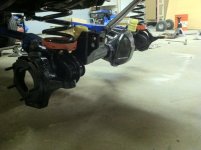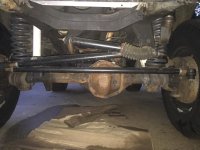Hey congrats! That's definitely good news. Glad to hear it's a bit more enjoyable to drive now, like it should be.
Yes to the steering re-center, but let's get our terminology consistent too, so we know we're on the same page. When you're centering the box, while you "might" use the steering wheel as your cue, DON'T use it at first. You just never know if the wheel or shaft have ever been pulled and re-oriented by a PO just to go the easy route in the past.
You may already have known that, but I wanted to run down the full setup just in case.
So, yes, recenter the box, but make sure that it's the box that is centered and that the steering wheel matches that.
1. If possible, drive to your work position so that you know the tires are pointed straight ahead. This isn't absolutely required, but it sure makes things easier to dial in.
2. Disconnect the draglink from the pitman arm (or the pitman arm from the box, whichever is easier for you).
3. Turn the steering wheel all the way to one extreme (steering lock) then count the turns exactly that it takes to get to the other lock. Some Ford boxes are as low as 3.5 turns, others are 4 or so, while other older ones might be as much as 6.25 turns lock-to-lock.
You need to be pretty precise on the count, so you can go exactly half-way back to the middle.
4. Find the center of the box by going half way back. So if you have a 4.5 turn box for example, you go back exactly 2.25 turns. This is the boxes on-center position from which you'll base all else.
If your steering wheel matches exactly, great! You're in luck and don't have to change anything. But if it's off slightly, don't do anything else until you've re-centered it on the box.
That might mean pulling the wheel and moving it over a spline or two, or pulling the steering shaft off the box and rotating it a spline or two. Whatever works for you.
Once you have the wheel reflecting the box, you're gold from here on out.
5. Adjust draglink length to match up to the tapered hole exactly. Run the nut down and torque to 40lbs and go for a drive.
If while you're driving you find that the steering wheel is cocked off a tiny bit (or more) you can then re-adjust the draglink length on the vehicle to pull the wheel (and therefor the box) back to centered.
The ultimate deciding factor is how it's aligned when you're driving, vs just sitting in the driveway. You might get it right on the money the first time, but often as not it's a teeny bit off when you go for your first drive.
No big deal, as that's what the adjustable draglink is actually for anyway. To fix that.
Sorry if you already knew that, but it's so important that the box be the center of the steering universe that I figured I'd run it down for anyone that is listening in.
Good luck.
Paul














